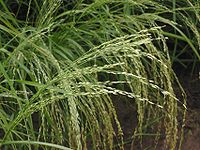
Photo from wikipedia
Assessing crop lodging at the regional scale is an important requirement for breeding lodging-resistant varieties and harvest planning. Accurately and continuously estimating crop lodging area from remote sensing data remains… Click to show full abstract
Assessing crop lodging at the regional scale is an important requirement for breeding lodging-resistant varieties and harvest planning. Accurately and continuously estimating crop lodging area from remote sensing data remains challenging due to the high randomness scattering signal of synthetic aperture radar (SAR) images and the insufficient number of applicable optical images. This study developed a new framework for estimating crop lodging area based on SAR data using the spatial aggregation approach of field units, overcoming the deficit of the traditional pixel-based approach susceptible to speckle noise and spatial heterogeneity. We aggregated the field’s pixel in SAR images using the spatial aggregation approach. The lodging area estimation models of dual-pol and quad-pol were established using a random forest (RF) algorithm. The Sobol approach evaluated the uncertainty and sensitivity at a regional scale. Finally, we analyzed the scattering mechanisms of the lodging field. Results indicate that the proposed method achieves the high performance of the lodging area estimates at the regional scale, in the testing set, with $R^{2}$ and root-mean-square error (RMSE) of the Gaofen-3 (GF-3) model being 0.57 and 18.63%, respectively, and the Sentinel-1 model is 0.49 and 20.59%. Besides, the uncertainties of models are below 10% and are insensitive to the variation of parameters intercorrelation. The depolarization effect and scattering randomness gradually weaken with the increase of lodging percentages. In contrast, the surface scattering quickly increases and finally dominates the total scattering after lodging percentages greater than 80%. This proposed approach would help develop a real-time crop lodging monitoring system using SAR data.
Journal Title: IEEE Transactions on Geoscience and Remote Sensing
Year Published: 2022
Link to full text (if available)
Share on Social Media: Sign Up to like & get
recommendations!